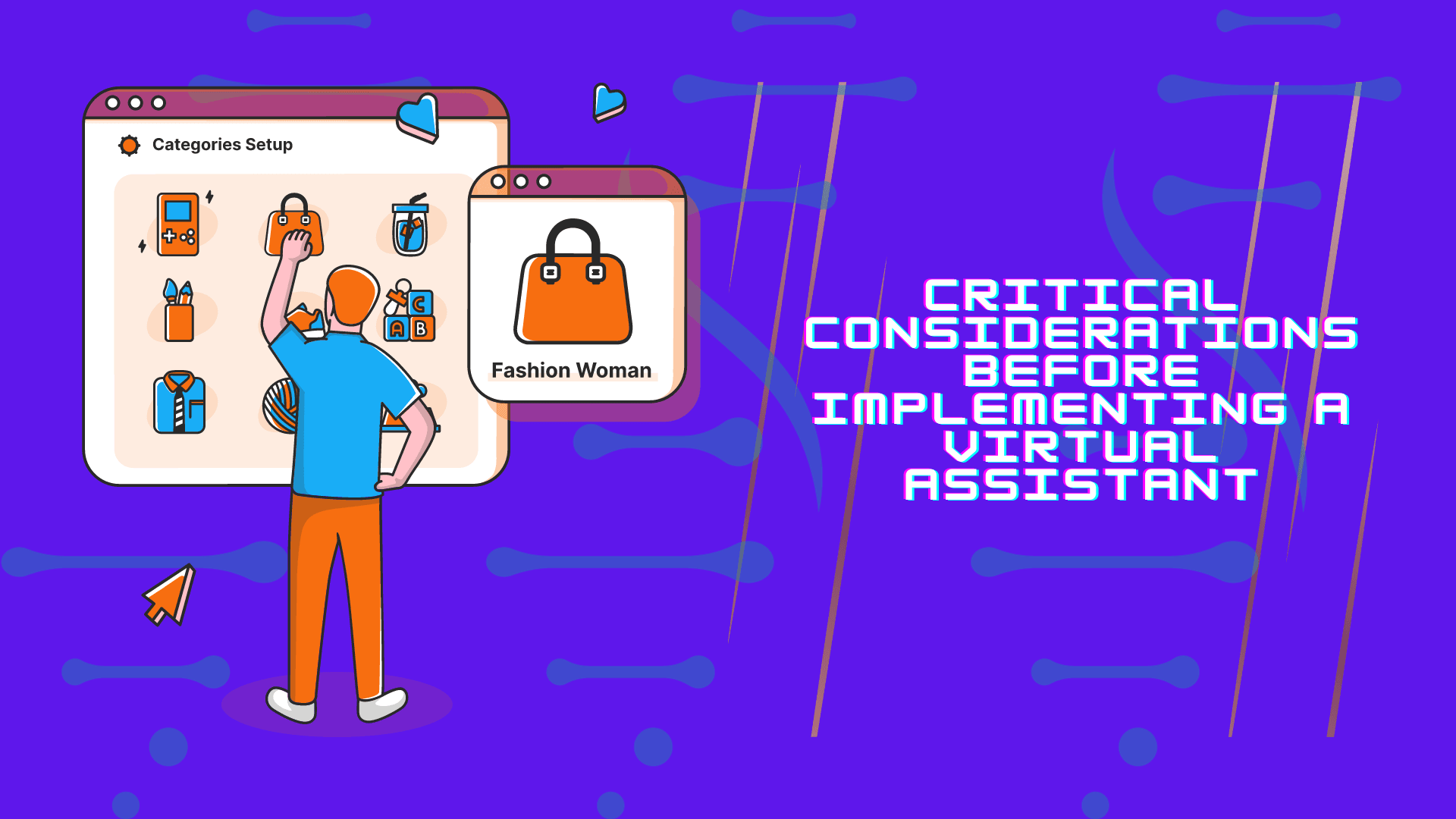Table of content
- Critical Considerations Before Implementing a Virtual Assistant
- Understanding Business Objectives: Defining the Purpose of the Virtual Assistant
- Evaluating Current Infrastructure: Assessing Compatibility and Scalability
- Budgetary Considerations: Aligning Investment with Business Goals
- User-Friendly Interface: Prioritizing Accessibility and Ease of Use
- Scalability: Ensuring the Virtual Assistant Grows with Your Business
- Regulatory Compliance: Navigating Legal and Ethical Considerations
- Employee Collaboration: Fostering a Synergistic Relationship with Human Staff
- Choosing the Right Virtual Assistant for E-commerce
- Integration Challenges and Solutions
- Compatibility Testing: Ensuring Seamless Integration with Existing Systems
- Data Migration: Navigating the Transfer of Information
- Workflow Disruption Mitigation: Strategizing for Minimal Impact
- API Solutions: Streamlining Integration through Application Programming Interfaces
- User Training: Preparing Teams for the Transition
- Continuous Testing: Identifying and Resolving Integration Issues Proactively
- Vendor Support and Collaboration: Engaging with Virtual Assistant Providers
- Impact on Customer Experience
- Security and Privacy Concerns
- Training and Optimization
Answering the Biggest Questions about Virtual Assistants for E-commerce Stores
Dec 08 2023
Table of content
- Critical Considerations Before Implementing a Virtual Assistant
- Understanding Business Objectives: Defining the Purpose of the Virtual Assistant
- Evaluating Current Infrastructure: Assessing Compatibility and Scalability
- Budgetary Considerations: Aligning Investment with Business Goals
- User-Friendly Interface: Prioritizing Accessibility and Ease of Use
- Scalability: Ensuring the Virtual Assistant Grows with Your Business
- Regulatory Compliance: Navigating Legal and Ethical Considerations
- Employee Collaboration: Fostering a Synergistic Relationship with Human Staff
- Choosing the Right Virtual Assistant for E-commerce
- Integration Challenges and Solutions
- Compatibility Testing: Ensuring Seamless Integration with Existing Systems
- Data Migration: Navigating the Transfer of Information
- Workflow Disruption Mitigation: Strategizing for Minimal Impact
- API Solutions: Streamlining Integration through Application Programming Interfaces
- User Training: Preparing Teams for the Transition
- Continuous Testing: Identifying and Resolving Integration Issues Proactively
- Vendor Support and Collaboration: Engaging with Virtual Assistant Providers
- Impact on Customer Experience
- Security and Privacy Concerns
- Training and Optimization

In the competition of the e-commerce landscape, one such technology gaining traction is virtual assistants for e-commerce stores. These digital aides, powered by artificial intelligence, promise to revolutionize online businesses' operations. However, before diving headfirst into the virtual assistant realm, it is crucial to address some of the biggest questions surrounding their implementation.
Critical Considerations Before Implementing a Virtual Assistant
Understanding Business Objectives: Defining the Purpose of the Virtual Assistant
Before venturing into the realm of virtual assistants, it's paramount to have a crystal-clear understanding of your business objectives. What specific tasks or processes do you intend the virtual assistant to handle? Whether it's streamlining customer support, managing orders, or optimizing data analysis, defining the purpose sets the foundation for a successful integration.
Evaluating Current Infrastructure: Assessing Compatibility and Scalability
Assessing the readiness of your existing infrastructure is a pivotal step. Is your e-commerce platform equipped to integrate seamlessly with a virtual assistant? Consider factors such as compatibility, scalability, and the potential impact on existing workflows. Conducting a thorough evaluation ensures that your infrastructure can support the integration without compromising performance or causing disruptions.
Budgetary Considerations: Aligning Investment with Business Goals
Implementing a virtual assistant involves associated costs, including software acquisition, integration, and ongoing maintenance. It's crucial to align your budgetary considerations with your business goals. Understanding the return on investment (ROI) and potential cost savings from increased efficiency helps determine the appropriate level of investment in a virtual assistant solution.
Explore CXGenie and hire your first virtual assistant for your e-commerce store at no cost today.
User-Friendly Interface: Prioritizing Accessibility and Ease of Use
The success of a virtual assistant is dependent on its user-friendliness. Consider the interface from both customer and employee perspectives. A user-friendly design ensures that customers interacting with the virtual assistant and employees managing its functions find it intuitive and easy to use. This, in turn, contributes to a seamless and positive user experience.
Scalability: Ensuring the Virtual Assistant Grows with Your Business
As your e-commerce business expands, so should the capabilities of your virtual assistant. Choosing a solution with scalability in mind ensures that it can adapt to the increasing demands of your business. Scalability is crucial for accommodating growing customer interactions, expanding product catalogs, and evolving business processes without requiring frequent overhauls or replacements.
See how to level up your Shopify virtual assistant skills at CXGenie.
Regulatory Compliance: Navigating Legal and Ethical Considerations
Implementing a virtual assistant for e-commerce stores involves handling sensitive customer data, necessitating adherence to regulatory standards. Ensure the virtual assistant solution complies with data protection laws and industry regulations. Transparency in data usage and a commitment to ethical practices build trust with customers, mitigating the risk of legal complications and safeguarding your business reputation.
Employee Collaboration: Fostering a Synergistic Relationship with Human Staff
Integrating a virtual assistant doesn't mean replacing human roles but augmenting them. Consider how the virtual assistant can collaborate with human staff to enhance productivity. Employee training and involvement in the integration process are crucial to fostering a synergistic relationship. Clearly defining the roles of both virtual and human components ensures a harmonious coexistence that maximizes overall efficiency.

By delving into these critical considerations, businesses can embark on implementing a virtual assistant e-commerce for stores with a comprehensive and strategic approach. This thorough preparation sets the stage for a successful integration that aligns with business objectives, enhances operational efficiency, and contributes to a positive customer experience.
Choosing the Right Virtual Assistant for E-commerce
The market offers many virtual assistant options, each with unique features and capabilities. Selecting the right virtual assistant for your e-commerce store involves thoroughly evaluating your business requirements. Factors such as natural language processing, response time, and customization options are pivotal in making an informed decision.
Moreover, consider the adaptability of the virtual assistant to your industry-specific needs. An e-commerce store may have distinct requirements compared to other sectors, and choosing a virtual assistant tailored to your niche can significantly enhance its effectiveness.
Discover how to choose the best Chatbot Shopify for your business.

Integration Challenges and Solutions
Integrating a virtual assistant into an existing e-commerce ecosystem may pose particular challenges. Common hurdles include compatibility issues, data migration concerns, and potential workflow disruption. However, these challenges can be mitigated with careful planning and a strategic approach.
Compatibility Testing: Ensuring Seamless Integration with Existing Systems
One of the primary challenges in implementing a virtual assistant for e-commerce stores is ensuring compatibility with your existing e-commerce systems. Conduct compatibility testing to identify potential conflicts and provide a seamless integration process. This step minimizes disruptions to your operations and helps guarantee that the virtual assistant functions harmoniously within your established technological ecosystem.
Data Migration: Navigating the Transfer of Information
Transferring data to the virtual assistant can be complex, especially if your e-commerce store has a vast database. Implementing a meticulous data migration plan helps smooth the transfer of relevant information. This includes customer profiles, purchase history, and product details. By strategizing the migration process, you can maintain data accuracy and prevent any loss of critical information during the Transition.
Workflow Disruption Mitigation: Strategizing for Minimal Impact
Integration may temporarily disrupt existing workflows, affecting customer service and order processing. Develop a strategic plan outlining the specific integration stages to mitigate these disruptions. Consider implementing the virtual assistant gradually, starting with less critical tasks. This phased approach allows your team to adapt to changes without compromising overall efficiency.
API Solutions: Streamlining Integration through Application Programming Interfaces
Leveraging Application Programming Interfaces (APIs) can significantly streamline the integration process. Ensure your virtual assistant solution offers robust API support, facilitating communication and data exchange between the assistant and your e-commerce platform. This approach enhances the interoperability of systems, enabling a more efficient and effective integration.
User Training: Preparing Teams for the Transition
Employee training is a key component of successful virtual assistant integration. Prepare your team with the needed skills to interact with and manage the virtual assistant effectively. Comprehensive training programs ensure employees are comfortable with the new technology, reducing the learning curve and contributing to a smoother transition.
Continuous Testing: Identifying and Resolving Integration Issues Proactively
Integration challenges may take time to be apparent, and issues could surface after implementation. To proactively address such challenges, establish a continuous testing process. Regularly monitor the virtual assistant's interactions, evaluate its performance, and address any emerging issues promptly. This iterative testing approach helps identify and resolve integration challenges before they impact the overall functionality of your e-commerce store.
Vendor Support and Collaboration: Engaging with Virtual Assistant Providers
Maintaining an open line of communication with your virtual assistant provider is crucial. Establish clear channels for support and collaboration, ensuring you can quickly resolve any issues post-implementation. A collaborative relationship with the vendor contributes to ongoing optimization and the seamless resolution of integration challenges as your business evolves.

By navigating these integration challenges with a systematic and strategic approach, businesses can ensure a successful incorporation of virtual assistants into their e-commerce operations. This comprehensive planning minimizes potential disruptions and maximizes the benefits that a well-integrated virtual assistant can bring to the efficiency and effectiveness of your online store.
Impact on Customer Experience
One of the primary motivations behind implementing a virtual assistant for e-commerce stores is to enhance the customer experience. A well-implemented virtual assistant can provide instant support, personalized recommendations, and a more efficient shopping process. Understanding the customer journey and tailoring the virtual assistant's capabilities to align with these touchpoints is crucial for a positive impact.
However, it's essential to strike the right balance between automation and human touch. While virtual assistants can handle routine tasks, human intervention may be required for complex queries or unique customer interactions. Striving for a harmonious coexistence between virtual and human assistance ensures a holistic and satisfying customer experience.
Humor can be a key to attracting your customers. See how to make your chatbot hilarious.

Security and Privacy Concerns
Security and privacy concerns are paramount as virtual assistants handle sensitive customer data. Addressing these concerns requires a comprehensive approach encompassing data encryption, secure communication channels, and adherence to regulatory standards.
Choosing a virtual assistant provider with a robust security framework is non-negotiable. Transparency with customers about data usage and privacy policies also fosters trust and confidence. Regular security audits and updates are the keys to staying ahead of evolving threats and maintaining a secure environment for businesses and customers.
To understand this better, you should address Shopify virtual assistant hiring concerns.
Training and Optimization
The effectiveness of a virtual assistant hinges on its training and continuous optimization. Investing time and resources in training the virtual assistant to understand industry-specific nuances, customer preferences, and evolving trends is essential for optimal performance.
Regularly monitoring and analyzing the virtual assistant's interactions provides valuable insights for ongoing optimization. Utilizing analytics tools, feedback loops, and customer surveys can help indicate areas for improvement and refine the virtual assistant's capabilities over time. A proactive approach to training and optimization ensures that the virtual assistant evolves with the changing dynamics of your e-commerce business.
In conclusion, implementing a virtual assistant for your e-commerce store requires careful consideration and strategic planning. Addressing key considerations, choosing the right virtual assistant, overcoming integration challenges, prioritizing customer experience, managing security and privacy concerns, and investing in ongoing training and optimization are crucial steps in maximizing the benefits of this innovative technology.
As the e-commerce landscape evolves, embracing virtual assistants can position your business at the forefront of customer service and efficiency. If you stay informed and take a proactive approach, you can harness the power of virtual assistants to propel your e-commerce store to new heights.
Related articles
No data



